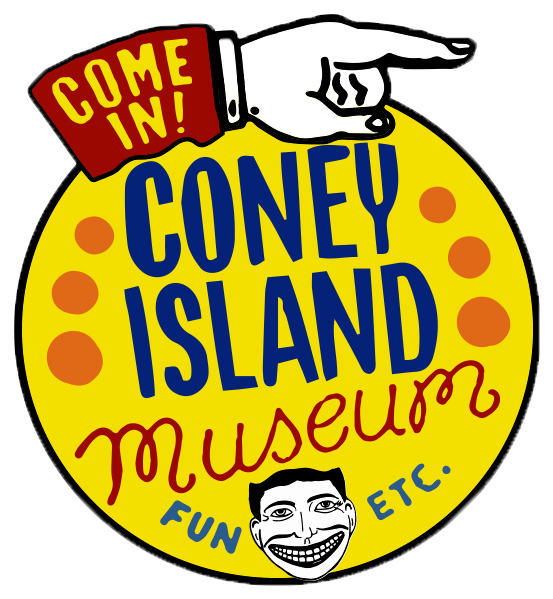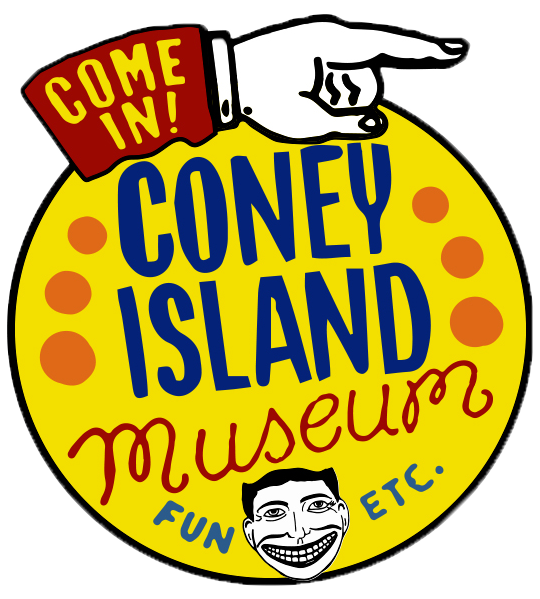Coney Island Carousell Horses
From art to artifact, the thrills and wonder of Coney Island’s past are on display at the Coney Island Museum!
Left: Morgan Urgo, Cate Mahoney, and Lisa Mangels Schaefer.
Speaking of thrills — that word pretty much sums up our reaction to a recent gift from our good friends at the New England Carousel Museum! We’re so grateful to Director Morgan Urgo, and her associate Cate Mahoney, as well as John Caruso of the National Carousel Association, for this exceptionally generous gesture.
This early 20th century carousel horse originated from the workshop of Marcus Charles Illions, in Coney Island. Regarded as “the Michelangelo of carousel carvers”, Illions was a Russian immigrant who spent his early career working with many other carousel crafters of renown, including Looff and, perhaps most famously, W.F. Mangels. In 1908, he established his own workshop on West Eighth Street in Coney Island, where he produced his own carousels.
Illions was an amazing artist, and not above carving his signature — or even his own portrait — onto his horses. His artistry can still be seen (though not ridden) at Coney Island’s B & B Carousell, which features Illion’s stunning Lincoln Centennial Horse.
This Illions carousel horse is an important acquisition for the CIM, illuminating Coney Island’s history as the once carousel capital of the world, home to many of the most celebrated merry-go-rounds, artisans, and manufacturers in the industry. This horse is going to need a major restoration to return it to its former glory; we hope you’re willing to take the ride with us as we welcome this precious piece of Coney Island’s past back home!
Above right: Illions carousel horse, c. early 20th century. Look at that handsome face!
“Smarty Charles”; Carousel horse; Charles Dare; c. early 20th century. Courtesy of Mr. Christopher Madden
Since 2018, visitors to the CIM have had the opportunity to view this charming horse, crafted by Charles Dare (1834-1896). Dare began his career carving toys, hobbyhorses, and rocking horses, but later progressed to carousel production. At his workshop in Greenpoint, Brooklyn, Dare primarily produced portable carousels, his sweet-faced horses carved in the “Country Fair” style. This particular Dare horse (nicknamed “Smarty Charles” by his owner”) was originally from a track machine — the horses would move forward and back on a track as the carousel platform revolved. It was later converted into a pole-style horse. Some of the early Dare carousels had horses suspended by ropes or wires, and were called “Flying Horses”.
Left: “Smarty Charles” and “Charlie” at home in the CIN’s Main Gallery.
Also new to the Coney Island Museum is this beauty! Nicknamed “Charlie” by his owner, this Looff horse, an outside stander, was once part of a carousel that was donated to the John and Mable Ringling Museum, part of their Circus Gallery Collection.
Coney Island’s first carousel was built by Charles Looff, and installed in 1876 at Vanderveer's Bathing Pavilion at West Sixth St. and Surf Avenue. Looff, a Danish immigrant, is credited with originating the “Coney Island” style of carousel carving, characterized by arched necks, dramatic poses, and elegant trappings. His workshop employed a cadre of artists and craftsmen, including M.C. Illions, Charles Carmel, Solomon Stein, and Harry Goldstein, as well as carousel innovator W.F. Mangels — all of whom would go on to create some of the most beautiful and memorable carousels in history. Looff left Coney Island in 1896, but continued to produce carousels.
“First Carousell at Coney Island N.Y. 1876” Charles Looff is identified at the center of the image. Also note the spelling of “Carousell”; this iteration would be used by many carousel producers of the era, including Looff, M.C. Illions, and W.F. Mangels, and can still be seen on the B & B Carousell in Coney Island.
Since 1876, Coney Island has been home to as many as twenty four carousels. Today, only two remain — a kiddie carousel at Deno’s Wonder Wheel Park, and the legendary B & B Carousell. For over sixty years this long-time Coney favorite operated on Surf Avenue, but when owners Mike Saltzstein and Jim McCullough lost their lease, the carousel was slated to be broken up and sold. Fortunately, in 2003 it was purchased and donated to NYC. In 2013, it was installed in a new pavilion on the Boardwalk, its Mangels frame and Carmel horses completely restored (sadly, minus its classic ring-catch mechanism). It was added to the National Register of Historic Places in 2016.
Did you know — Most American-built carousels turn counter-clockwise (right to left ). For this reason, the outside horses are typically the largest and most ornate. Additionally, the right side of a carousel horse (the out- facing), is referred to as the “romance” side, and is also the most embellished; the left side is the “apprentice” side, for obvious reasons.







